The Polaris Ranger Mid-Size is a popular utility vehicle for outdoor activities. Like most vehicles, it has an electrical system that requires occasional maintenance. The electrical system on the Polaris Ranger Mid-Size can cause problems for riders, and many of these issues stem from the battery. If your battery is old or worn out, it may cause electrical problems for your vehicle. Additionally, cold weather is notorious for killing batteries, which is something to watch out for if you plan to store your Ranger during winter months in a place that is not temperature controlled.
To keep your battery running strong during cold weather, there are a few things you can do. One option is to run a secondary battery. By purchasing two AGM batteries with a voltage sensing isolator, you can ensure that you will be able to plow, winch, and run your Ranger without issues even in the coldest weather. Another option is to run car batteries with booster cables, disconnecting the cables when not in use. However, this is not as reliable as the secondary battery solution.
Grounding issues are another common problem with Polaris Ranger Mid-Size electrical systems. Understanding Mid-Size fault codes can help in this regard, allowing riders to pinpoint the area of the electrical system where the issue is occurring. If you do need to troubleshoot your Ranger's electrical system, it may take some work to find the specific wire or harness that is touching metal or burnt, so be prepared for some time-consuming testing. Unplugging harnesses at both ends and testing them one wire at a time is often the best way to identify the issue.
Preventive measures can also be taken to proactively deter electric problems on your Polaris Ranger. For example, applying dielectric grease on all electric plugs and spark plugs can help prevent mud and water from cutting out the flow of electricity across the system. Similarly, using WD-40 can be a temporary fix for a cracked or faulty sealed coil. Aftermarket airboxes can also stop mud and water from getting on the mass airflow sensor, and unlike dielectric grease and WD-40, airbox upgrades are a more permanent solution.
If you do start to mess around with the electric workings of your Polaris Mid-Size, make sure to get an electric model manual for guidance. This will help you to avoid making mistakes and causing more problems with your vehicle. By taking preventive measures and addressing issues as they arise, you can keep your Polaris Ranger Mid-Size running smoothly and avoid costly repairs or replacements in the future.






